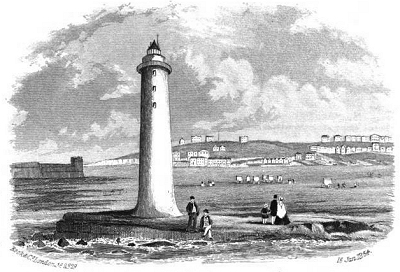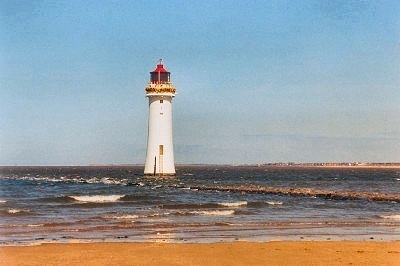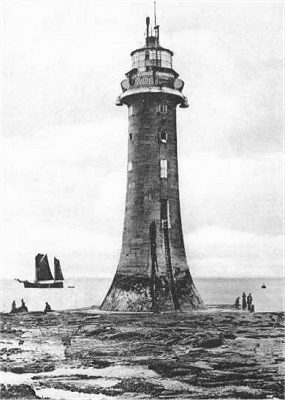 |
| The
Rock Lighthouse and Everton Hill c.1850 |
 |
| The
Rock Lighthouse, Fort Perch Rock and the Red
Noses c.1850 |
 |
|
| The Rock
Lighthouse, New Brighton |
| The
Rock Lighthouse, or Perch Rock
Lighthouse, next to Fort Perch Rock,
marks the extreme northern tip of the Wirral. The
first structure here, erected in 1683, was a
large wooden tripod or perch bholding a fire,
hence the current name (formerly Black Rock).
This was regularly destroyed by shipping and
acquired a light in the early 19th century.
Nevertheless it was demolished again in 1821 when
a Mersey pilot boat collided with it during a
storm. |
| The
present lighthouse is 93 ft (28 m) high and of
very solid construction, costing £27,500 by the
time it was completed in 1830. It had possibly
the first revolving light in the country. It was
decommissioned in 1973 when its role was
superceded by the radar system at Crosby. |
| James
Stonehouse has this to say in his A New and
Complete Handbook for the Stranger in Liverpool
(c.1848). |
| |
0n the Cheshire
shore is the Rock Perch or Black Rock Lighthouse
which is erected at the north east point of the
Wirral peninsula. It is a very substantial and
elegant building. The foundation stone was laid
by Thomas Littledale Esq., 8th June, 1827, from a
design by Mr. Foster. It was completed, and the
light exhibited, 1st March, 1830. It rises ninety
feet above the level of the rock exclusive of the
lanthorn. The diameter of the base is thirty five
feet. The masonry is solid up to about thirty-six
feet, where a spiral staircase commences to the
apartments of those in charge of the lights. It
is constructed entirely of hard stone from the
Isle of Anglesea. [...] The cost of this
lighthouse was £27,500. The lights revolve by
machinery exhibiting two white lights and one
deep crimson light every three minutes. [...]
Bells are tolled in foggy weather and there are
flag posts for signals on the roof. Previous to
the erection of this building the Rock Point was
marked by a beacon. [...] At low water an
extensive bed of mussels may be discovered
surrounding the lighthouse. |
|
 |
| The
Rock Perch in the late 18th century |
 |
| The
Rock Lighthouse c.1900? |
|